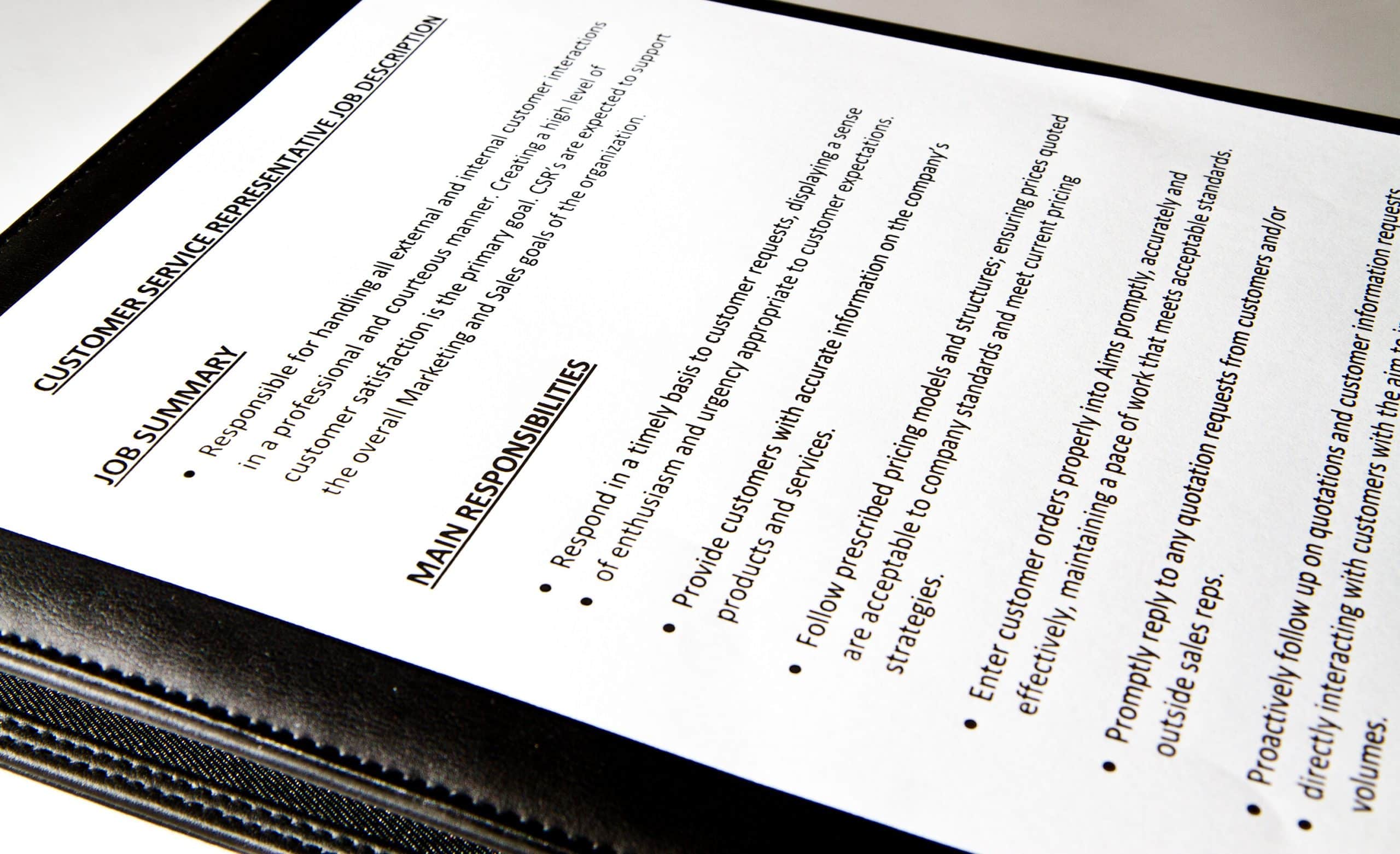How to Make a Job Description
A job description is a useful, plain-language tool that explains the tasks, duties, function and responsibilities of a position. It details who performs a specific type of work, how that work is to be completed, and the frequency and the purpose of the work as it relates to the organization’s mission and goals. Job descriptions are used for a variety of reasons, such as determining salary levels, conducting performance reviews, clarifying missions, establishing titles and pay grades, and creating reasonable accommodation controls, and as a tool for recruiting. Job descriptions are useful in career planning, offering training exercises and establishing legal requirements for compliance purposes. A job description gives an employee a clear and concise resource to be used as a guide for job performance. Likewise, a supervisor can use a job description as a measuring tool to ensure that the employee is meeting job expectations.
Step 1: Perform a Job Analysis
This process of gathering, examining and interpreting data about the job’s tasks will supply accurate information about the job so that an organization can perform efficiently. Performing a job analysis includes the following steps:
- Interviewing employees to find out exactly what tasks are being performed.
- Observing how tasks are performed.
- Having employees fill out questionnaires or worksheets.
The results should be documented and reviewed by the employee who is currently in the position—and his or her supervisor—for any changes regarding the knowledge, skills, abilities, physical characteristics, environmental factors and credentials/experience of the position:
- Knowledge—comprehension of a body of information acquired by experience or study.
- Skill—a present, observable competence to perform a learned activity.
- Ability—competence to perform an observable behavior or a behavior that results in an observable product.
- Physical characteristics—the physical attributes an employee must have to perform the job duties with or without a reasonable accommodation.
- Environmental factors—working conditions (inside or outside the office).
- Credentials/experience—the minimum level of education, experience and certifications acceptable for the position.
Step 2: Establish the Essential Functions
Once the performance standard for a particular job has been made, essential functions of the position must be defined. This will provide a better avenue for evaluating Americans with Disabilities Act (ADA) accommodation requests. Defining the essential functions encompasses the following steps:
- Ensure that the tasks as part of the job function are truly necessary or a requirement to perform the job.
- Determine the frequency at which the task is performed or how much time is spent performing a task.
- Determine the consequences of not performing the function and whether this would be detrimental to the employer’s operation or result in severe consequences.
- Determine if the tasks can be redesigned or performed in another manner.
- Determine if the tasks can be reassigned to another employee.
Once the essential functions are defined, the employer can make a determination as to whether the functions are essential or marginal. The use of the term “essential function” should be part of the job description, and it should explicitly state how an individual is to perform the job. This will provide future guidance as to whether the job can be performed with or without an accommodation.
Step 3: Organize the Data Concisely
The structure of the job description may vary from company to company; however, all the job descriptions within an organization should be standardized so that they have the same appearance.
The following topics should be included:
- Job title—name of the position.
- Classification—exempt or nonexempt under the Fair Labor Standards Act (FLSA).
- Reports to—title of the position this job reports to.
- Date—date when the job description was written or last reviewed.
- Summary/objective—summary and overall objectives of the job.
- Essential functions—essential functions, including how an individual is to perform them and the frequency with which the tasks are performed; the tasks must be part of the job function and truly necessary or required to perform the job.
- Competency—knowledge, skills and abilities.
- Supervisory responsibilities—direct reports, if any, and the level of supervision.
- Work environment—the work environment; temperature, noise level, inside or outside,or other factors that will affect the person’s working conditions while performing the job.
- Physical demands—the physical demands of the job, including bending, sitting, lifting and driving.
- Position type and expected hours of work—full time or part time, typical work hours and shifts, days of week, and whether overtime is expected.
- Travel—percentage of travel time expected for the position, where the travel occurs, such as locally or in specific countries or states, and whether the travel is overnight.
- Required education and experience—education and experience based on requirements that are job-related and consistent with business necessity.
- Preferred education and experience—preferred education and experience based on requirements that are job-related and consistent with business necessity.
- Additional eligibility qualifications—additional requirements such as certifications, industry-specific experience and the experience working with certain equipment.
- Affirmative action plan/equal employment opportunity (AAP/EEO) statement— clause(s) that outlines federal contractor requirements and practices and/or equal employer opportunity statement.
- Other duties—disclaimer, see Step 4.
Step 4: Add the Disclaimer
It is a good idea to add a statement that indicates that the job description is not designed to cover or contain a comprehensive listing of activities, duties or responsibilities that are required of the employee. Duties, responsibilities and activities may change or new ones may be assigned at any time with or without notice.
Step 5: Add the Signature Lines
Signatures are an important part of validating the job description. They show that the job description has been approved and that the employee understands the requirements, essential functions and duties of the position. Signatures should include those of the supervisor and of the employee.
Step 6: Finalize
A draft of the job description should be presented to upper management and the position supervisor for review and approval. A draft allows a chance to review, add or subtract any detail before the final job description is approved.
The final job descriptions should be kept in a secure location, and copies should be used for job postings, interviews, accommodation requests, compensation reviews and performance appraisals. Employers may also wish to post them on their intranet.
Looking for assistance developing job descriptions for your business? Learn more about our HR Consulting Services.





Reply a Comment